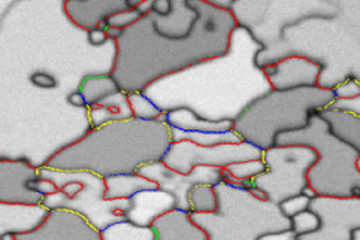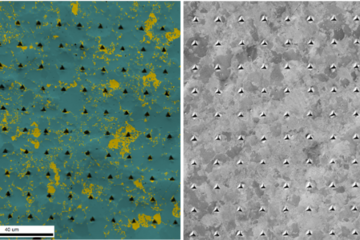All genres
441.
Talk
Machine learning-enabled tomographic imaging of chemical short-range ordering in CoCrNi alloy. TMS 2023, San Diego, CA, USA (2024)
442.
Talk
Machine Learning-enabled Tomographic Imaging of Chemical Short-range Order in Fe-based Solid-solutions. DPG 2024, Berlin, Germany (2024)
443.
Talk
Machine Learning-enabled Tomographic Imaging of Chemical Short-range Order in Fe-based Solid-solutions. TMS 2024, Orlando, FL, USA (2024)
444.
Talk
Atomic Scale Analysis Reveals the Interplay between Grain Boundary Structure and Composition. MRS 2023, Boston, MA, USA (2023)
445.
Talk
In-situ cryogenic protective layers and metal coatings in cryogenic FIB. IMC20 - 20th International Microscopy Congress - Pre-congress workshop, Cryogenic Atom Probe Tomography, Busan, South Korea (2023)
446.
Talk
Probing Dealloying Mechanisms in Thin-Film Nanoporous Metals Using Atom Probe Tomography. Atom Probe Tomography & Microscopy, Leuven, Belgium (2023)
447.
Talk
Machine learning-enabled tomographic imaging of chemical short-range ordering in CoCrNi alloys. APT&M 2023, Leuven, Belgium (2023)
448.
Talk
Visualizing radiation-induced damage by Hydrogen/Deuterium. APT&M, Frankfurt, Germany (2023)
449.
Talk
Site-specific preparation and atom probe tomography of bulk water ice and amino acid solutions. Atom Probe Tomography & Microscopy, Leuven, Belgium (2023)
450.
Talk
Identifying multielement active sites as a design strategy for high-performance laser-generated H2O2 electrocatalysts. Atom Probe Tomography & Microscopy conference, Leuven, Belgium (2023)
451.
Talk
Operando Study on the activation of hydrogen evolution electrocatalysts. NRF-DFG meeting “Electrodes for direct sea-water splitting and microstructure based stability analyses”, Korean Institute for Energy Research, Daejeon, South Korea (2023)
452.
Talk
Site-specific preparation and atom probe tomography of frozen liquids. IMC20 - 20th International Microscopy Congress, Busan, South Korea (2023)
453.
Talk
GIS-free metal coating in cryo-FIB: methods and use cases. IMC20 - 20th International Microscopy Congress, Busan, South Korea (2023)
454.
Talk
Operando Study on the corrosion of photo-electrocatalysts. NRF-DFG meeting “Electrodes for direct sea-water splitting and microstructure based stability analyses”, Kangwon National University, Chuncheon-si, South Korea (2023)
455.
Talk
The chemical, thermodynamic and kinetic roles of pores in the hydrogen-based direct reduction of single-crystalline wüstite into iron. EUROMAT 2023, Frankfurt, Germany (2023)
456.
Talk
Interaction of Hydrogen/ Deuterium with defects in two-phase steels. FEMS EUROMAT, Frankfurt, Germany (2023)
457.
Talk
New perspectives for in situ nanomechanics at cryogenic temperatures. FEMS EUROMAT 2023, Frankfurt, Germany (2023)
458.
Talk
Resolving grain boundary complexions in Copper by STEM and analyzing their impact on properties. Workshop Advanced Electron Microscopy in Materials Research, La Clusaz, France (2023)
459.
Talk
Experiment and Simulation Advances for atomic scale characterization using analytical field ion microscopy. Microscopy & Microanalysis 2023 (M&M 2023), Minneapolis, MN, USA (2023)
460.
Talk
Advanced Data Processing and Ab Initio Simulations for Insights into Atom Probe Tomography Correlations. Workshop on local probes of chemical bonding and atom probe tomography (RWTH), Aachen, Germany (2023)











